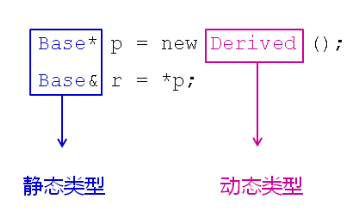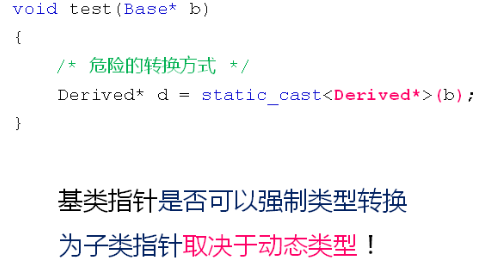一、类型识别
1、在面向对象中可能出现下面的问题
(1)、基类指针指向子类对象
(2)、基类引用成为子类对象的别名

A、静态类型: 变量(对象)自身的类型(期望的、确定的类型)
B、动态类型: 指针(引用)所指向实际对象的类型


2、解决方案
(1)、在类中定义虚函数返回具体类型的信息
(2)、所有的派生类都必须实现类型相关的虚函数
(3)、每个类中的虚函数都需要不同的实现
#include <iostream> #include <string> using namespace std; class Base { public: //在基类中提供个用来判断类型的虚函数 //并且所有的派生类中都必须实现这个函数 virtual string type() { return "Base"; //手动返回一个用于识别的标识符 } }; class Derived : public Base { public: string type() { return "Derived"; } void print() { cout << "I'm a Derived." << endl; } }; class Child : public Base { public: string type() { return "Child"; } }; void test(Base* b) { //危险的转换方式。因为b可能实际类型可能不是Derived的类型 //Derived* d = static_cast<Derived*>(b); if(b->type() == "Derived") { Derived* d = static_cast<Derived*>(b); d->print(); } //如果类中没有虚函数表,则调用dynamic_cast会直接报错,编译不过。 //当父、子类没有继承关系时,dynamic_cast返回false,否则会转换后 //实际对象的地址 cout << dynamic_cast<Derived*>(b) << endl; } int main() { Base b; Derived d; Child c; test(&b); //Base与Base没有继承关系,dynamic_cast返回false test(&d); //Derived与Base有继承关系,dynamic_cast转换后对象的地址 test(&c); //Child与Derived没有继承关系,返回false return 0; } /*输出结果: 0 I'm a Derived. 0x23feb8 0 */
3、多态解决方案的缺陷
(1)、必须从基类开始提供类型虚函数
(2)、所有的派生类都必须重写类型虚函数
(3)、每个派生类的类型名必须不唯一
二、类型识别关键字
1、c++提供了typeid关键字用于获取类型信息
(1)、typeid关键字返回对应参数的类型信息
(2)、typeid返回一个type_info类对象
(3)、当typeid的参数为NULL时将抛出异常
(4)typeid关键字的使用

2、typeid的注意事项
(1)、typeid关键字在不同编译器下对类型名的处理可能不同
(2)、当参数为类型时(如int),返回静态类型信息
(3)、当参数为变量时(如 i)
A、不存在虚函数表:返回静态类型信息
B、存在虚函数表:返回动态类型信息
#include <iostream> #include <string> #include <typeinfo> //for typeid using namespace std; class Base { public: virtual ~Base(){} }; class Derived : public Base { public: void print() { cout << "I'm a Derived." << endl; } }; void test(Base* b) { //const type_info& tb = typeid(b); //判断b的类型,Base*或Derived* const type_info& tb = typeid(*b); //判断对象的类型 cout << tb.name() << endl; } int main() { int i = 0; const type_info& tiv = typeid(i); //判断变量的类型 const type_info& tii = typeid(int); //判断类的类型 cout << (tiv == tii) << endl; //相等 Base b; Derived d; test(&b); test(&d);//无虚函数表数打印的类型名一样(因为Test参数为Base,即静态类型为Base),有虚函数表时则不一样 return 0; } /*输出结果: 1 4Base //g++下类名前面的数字表示类名的长度 7Derived */
三、小结
(1)、c++中有动态类型和静态类型的概念
(2)、利用多态能够实现对象的动态类型识别
(3)、typeid是专用于类型识别的关键字
(4)、typeid能够返回对象的动态类型信息